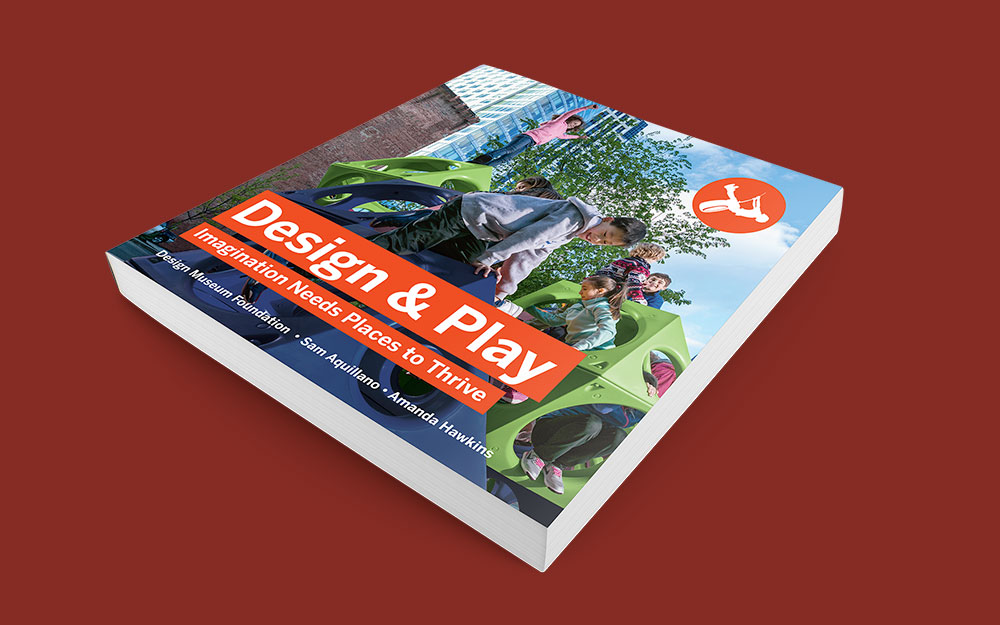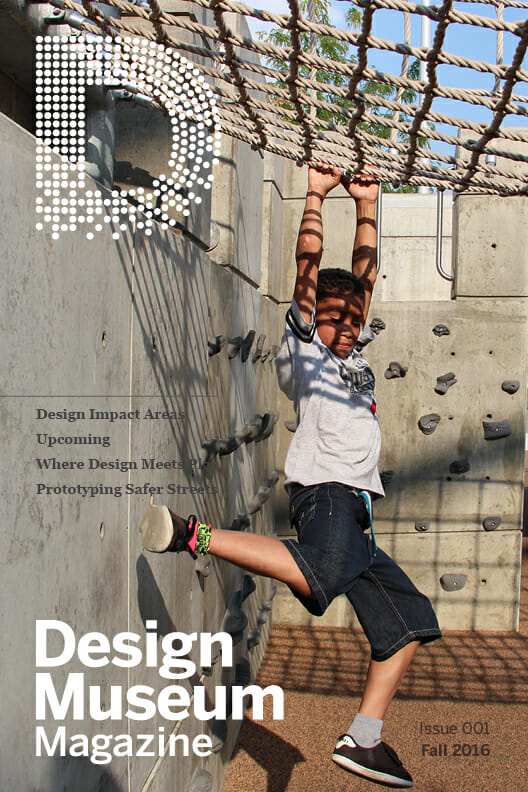Where Design Meets Play
A Research-Based Approach at Smale Riverfront Park
“It’s a place that seems a bit wild and a little risky, a place where the unexpected can happen.”
Images and illustrations courtesy of Sasaki Associates

By Kate Tooke, Senior Associate, Landscape Architect, Sasaki Associates
On a sunny Saturday afternoon in mid-October the playscape at Cincinnati’s Smale Riverfront Park is alive with children and families. Screams of delight come from the slide hillside, mixing with the comfortable chatter of a group of parents watching from the bottom. From my perch at the top of the slide hill I watch a little girl launch herself down the wide slide. She hollers cheerfully as she slips sideways on the bump halfway down, and careens off the end, taking a tumble before regaining her feet. I lose sight of her momentarily as she skips around a log path behind a copse of trees and shrubs.
A moment later she emerges halfway up the hillside, balancing with arms out-stretched on a series of upturned logs. I feel her brush past me as she gets to the top, arms still out wide and making a whooshing noise, as though she is imagining herself a bird. She pauses at the top of a rocky outcrop, just as an older boy runs past and takes a flying leap off the rocks, with a friend in hot pursuit. For a moment she looks back at me, a question in her eyes, and then turns to jump herself, landing like a frog on hands and feet at the bottom of the valley. Her attention is immediately caught by a group of preteen girls at the base of the climbing wall. I come closer to the top of the structure to watch as she sidles up to the group. “I can’t do it” one girl is saying, while the others offer encouragement and advice on where to put her feet and hands. “Watch me!” the littlest girl exclaims, and begins to climb, stretching her body into its longest forms flat against the wall. At the top she turns and flashes me a big smile, eyes shining. “Mama,” she shouts, “come do the rope bridge with me!” I put my clipboard down and run after her because this weekend I am splitting my time between researching and parenting.
My daughter, Tessa, and I are in Cincinnati with a team of designers to conduct a post-occupancy evaluation of the new playscape at the Smale Riverfront Park. The park sits on the banks of the Ohio River in a district dominated by sports venues, between the Paul Brown Stadium and the Great American Ball Park. But these families didn’t come downtown to root for the home team, they are here specifically to play outside. It’s not that Cincinnati has any deficit of playgrounds: in fact, the Trust for Public Land ranks it number two in the nation when it comes to playgrounds per capita.(1) But in the brief six months since this playscape opened, it has become a major destination for the region’s families. Throughout the summer the park teemed with children. A park maintenance staffer said some parts of the park had “at least one child per square foot” on hot July Saturdays.
In part, the park is so popular because it is so different. Here, instead of the standard plastic post-and-platform structures of a typical American playground, climbing walls, boulders, bridges, logs and slide hillsides await curious kids. It’s a place that seems a bit wild and a little risky, a place where the unexpected can happen. One mother told me that her son is quickly bored at other playgrounds, but “here [at Smale] we can spend hours, and he never wants to leave.” Another said, “this is the best place to play anywhere near Cincinnati – my kids can actually run, climb, jump, get wet, play a giant foot piano, and freely raise their voices here. There’s enough challenge that they can feel proud of themselves and enough variety that we’ll keep coming back again and again.”
The refreshing change of pace that these visitors experienced at Smale is part of a nationwide movement to re-invigorate outdoor playspaces. Susan Solomon, author of American Playgrounds: Revitalizing Community Space, describes today’s default playground as “the McDonald’s model”: a garishly-colored and unimaginative collection of posts, platforms, tunnels, and slides stamped uniformly across the country. “Things like taking risks, learning to fail, learning to master something, to plan ahead, to develop deep friendships,” Solomon says, “none of those could take place on most playgrounds today.” Children are suffering as a result: physically, mentally and emotionally. A recent study in the Journal of Pediatrics found that when children are bored by “safe” play equipment, they are less likely to be physically active, and therefore more prone to obesity.(2) There are intellectual and emotional effects too. A lack of free play opportunities is responsible for a generation of children who are less imaginative, creative and expressive, according to Kyung-Hee Kim, an educational psychologist at the College of William and Mary and the author of the 2011 paper The Creativity Crisis.(3) Ellen Sandsetter, a Norwegian psychologist and author of Children’s Risky Play from an Evolutionary Perspective writes that protecting children on “safe” playgrounds results in “more fearful children and increased levels of psychopathology.”(4) The list of ills is extensive, so why have modern playgrounds ended up this way?

Today’s “McDonald’s model” playgrounds have been shaped largely by risk aversion within a litigious culture, and by overzealous safety guidelines that are meant to appease these fears. A series of high profile playground injuries and lawsuits in the late 1970s gave rise to the first Handbook for Public Playground Safety, published by the US Consumer Product Safety Commission in 1981. Over the following two decades cities removed “dangerous” play equipment from parks, schools and other public places and replaced it with structures and surfacing deemed “safe”. Yet there is little evidence about the efficacy of this focus on safety: in fact, emergency room visits due to playground injuries have remained steady since 1982.(5) David Ball, a professor of risk management at Middlesex University in the UK is uncovering statistics that broken bones may actually be on the rise due to a phenomenon he calls “risk compensation”: kids aren’t as careful because play equipment and surfacing seem so safe, and they end up hurting themselves more often.
Over the past decade a groundswell of play advocates – including parents, teachers and designers – have begun arguing that a reasonable level of risk in play is essential to children’s healthy development. Play scholarship uses the term risk as a shorthand for environments and activities that challenge children’s physical coordination, social skills, creative imagination and other desirable qualities. A 2015 study led by Sandsetter found that environments supportive of risky (challenging and exciting) play promoted physical activity, social interactions, creativity and resiliency among children, and argued that the overall positive effects of increased risky play provide a greater benefit than the possible negative consequences of injury.(6) A recent popular article in the Atlantic Magazine titled “The Overprotected Kid” highlighted a junkyard-style playground in Scotland called “the Land” where children light fires and use saws and hammers to build whatever strikes their fancy.5 While this represents one extreme, the pendulum is slowly swinging back from the bland environs of safety towards the thrill of risk. And that shift means that cities increasingly eschew off-the-shelf playgrounds, instead engaging designers in the creation of custom play environments that are contextual, place-specific and creative in their interpretation of the safety guidelines to open up a sense of adventure, healthy risk and challenge. Michael Van Valkenburgh Associates’ Teardrop Park in New York City was among the first visible American examples of a new playground model. The playscapes at Smale Riverfront Park have put Cincinnati on the map of what an innovative landscape of play can look like in 21st century America.
The Backstory
The making of the Smale Riverfront Park is a story of transformation that spans several decades. Back in the mid 1990s, most of the site was a brownfield along the banks of the Ohio River. Like so many post-industrial riverfronts across the U.S., it was covered in parking lots and vacant industrial parcels that flooded regularly. The old Riverfront Stadium, a multipurpose field which had been home to both the Cincinnati Reds and Bengals since 1970 occupied the parcel to the east of the Roebling Bridge and was in disrepair. Mehring Way, a four lane highway, ran along the riverbank, divorcing the city from the water. Vacancy rates in the surrounding areas were among the highest in the city.
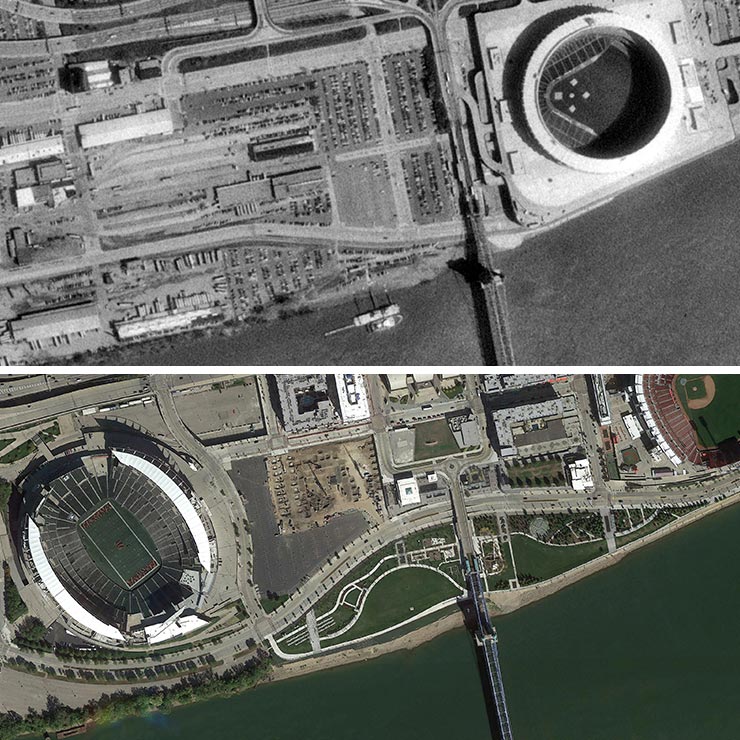
The site for Smale Riverfront Park before and after a reimagining of the waterfront.
In the late 1990s the city initiated a masterplan process for the district. Over a two year period, an extensive public and private input process identified and vetted key priorities. The final plan, approved in 1999, included several bold ideas: first, move Mehring Way away from the banks of the river to create room for a 14-acre park in the floodplain. Second, construct new baseball and football stadiums to anchor the parkland on either side and provide an economic engine for the area. Third, develop the area north of Mehring Way raised above the floodplain with floodable parking underneath. The entire plan encompassed more than 32 acres of riverfront.
Sasaki’s role in the riverfront’s transformation began in 1999 when it was selected to develop concept plans for the park areas identified in the Master Plan. A team of landscape architects, urban planners and engineers conceived a multiphase approach that would begin by making room for the park. By 2004, the Great American Ball Park had been moved east and the Paul Brown football stadium had been constructed to the west. Mehring Way moved north in 2010, in conjunction with construction of the event lawn, fountains, stairs, and brewery. Resiliency to flooding was designed into every detail of these areas, and the work required an in-depth permitting process with the Army Corps of Engineers.
The park’s dedicated playscapes – the Heekin Family/Grow Up Great Adventure Playscape and the P&G goVibrantscape – are both sited within the floodplain and opened together in the late spring of 2015. Collectively they blur the traditional boundaries between park and playground: there are no fences separating the zones from each other or from the rest of the park. Instead, children and families enter the spaces fluidly from all directions, and play spills out into nearby lawns, paths, and the flexible area beneath the bridge abutment. In addition, the park as a whole is a destination for families, including attractions like Carol Ann’s Carousel, fountains, and a labyrinth, as well as places to picnic, rent bikes, swing or sit by the river. Many families we interviewed in October described coming to the area for a whole day of outdoor adventure and exploration. Today, two decades after the design process began, the playscapes seem like they were always meant to be here.
Designing the Playscapes
In 1999 the park’s masterplan had called generally for some kind of children’s playground to be included on the lower level by the river, but gave no specifics regarding placement or typology. As the design team and Park Board began the design process, we considered everything from standard playground equipment to simple sloped lawns. But bold ideas about creating a new breed of imaginative and active play space captured the whole team early in the process. By 2013, when the design began in earnest, there was consensus that the playgrounds would set a new standard. “We wanted a place of adventure and challenge, and not a typical playground composed of off-the-shelf components,” says Steven Schuckman, Superintendent of Planning and Design for Cincinnati Parks. The goal, he says, was to create a playground “as unique and grounded in the site and its history as is the rest of the park.”

At the same time, three important private funding sources stepped forward: The Heekin Family, PNC Bank, and Proctor & Gamble. The Heekin Family along with PNC Bank donated generously towards a playground that would inspire and challenge Cincinnati’s children to be physically active. Proctor & Gamble’s charitable foundation offered a grant to create a playful, interactive space that would engage children and families together in explorations of cause and effect, promoting physical exercise in a fun way. The support of the Park Board to create an adventure-style playscape, aligned with the goals of the funders, and formed a strong foundation for conceptual design.
Early sketches and studies of the PNC/Heekin Adventure Playscape drew inspiration from the cultural and environmental history of the site. The story of the Ohio River – from its geologic beginnings to its role in settlement and industry to its seasonal flooding patterns – captivated the design team and grounded the design. A valley emerged as a central organizing element, reminiscent of the way the river has carved the landscape over time. Two bridges over the valley evoke the rhythm of the river’s many crossings, especially the historic Roebling suspension bridge which bisects the Smale Riverfront Park on its way to Kentucky. The log climbing feature drew upon the log jams common during flooding events. Likewise, the materiality of the playscape drew heavily from the local area: the rock outcrops are built from large pieces of local sandstone, which also make up the abutments of the adjacent Roebling Bridge, while most of the wood features throughout the playscape are a rot-resistant native locust tree sourced from downed trees in other Cincinnati public parks.
A research-based process helped inform the layout and specific features of the PNC/Heekin Adventure Playscape. The design responded to six categories of risky play, as defined by Sandsetter: fast motion, unsupervised & exploration, natural elements, great heights, rough & tumble, and using tools.8 Elements like the slide, climbing walls and bridges were designed specifically to help kids achieve feelings of great heights and rapid speeds, while small nooks in the rock outcrops and winding paths capture a sense of mystery and the feeling that one could disappear. Most of the elements incorporate some sense of danger – a foot could fall through the mesh of the rope bridge, a hand could slip at the top of the climbing wall – without actually being dangerous. Teri Hendy, a play consultant who specializes in alternative play environments, worked with the design team to ensure that each of the custom designed features met all the standards of the Public Playground Safety Handbook.
Although a definite focus of the PNC/Heekin Adventure playscape is to provide a physical outlet and challenge for children, the design team sought to incorporate other types of play. Sara Smilanski, a renowned Israeli child psychologist who trained with Jean Piaget, developed a widely-accepted theory in the late 1960’s about four types of play that contribute to children’s learning and development. They are (1) functional play involving physical and gross-motor activities, (2) constructive play including building and creating, (3) dramatic play that engages imagination and role playing, and (4) games with rules. Our early design conversations focused particularly on how to incorporate dramatic and constructive play into such an active and physical space. The fog misters at the northern amphitheater are cooling in the summer but are also intended to evoke a sense of mystery that might spark imaginative activities. We worked with a local artist to embed fossil-carved stones into the rock outcrops to promote a sense of discovery and wonderment.
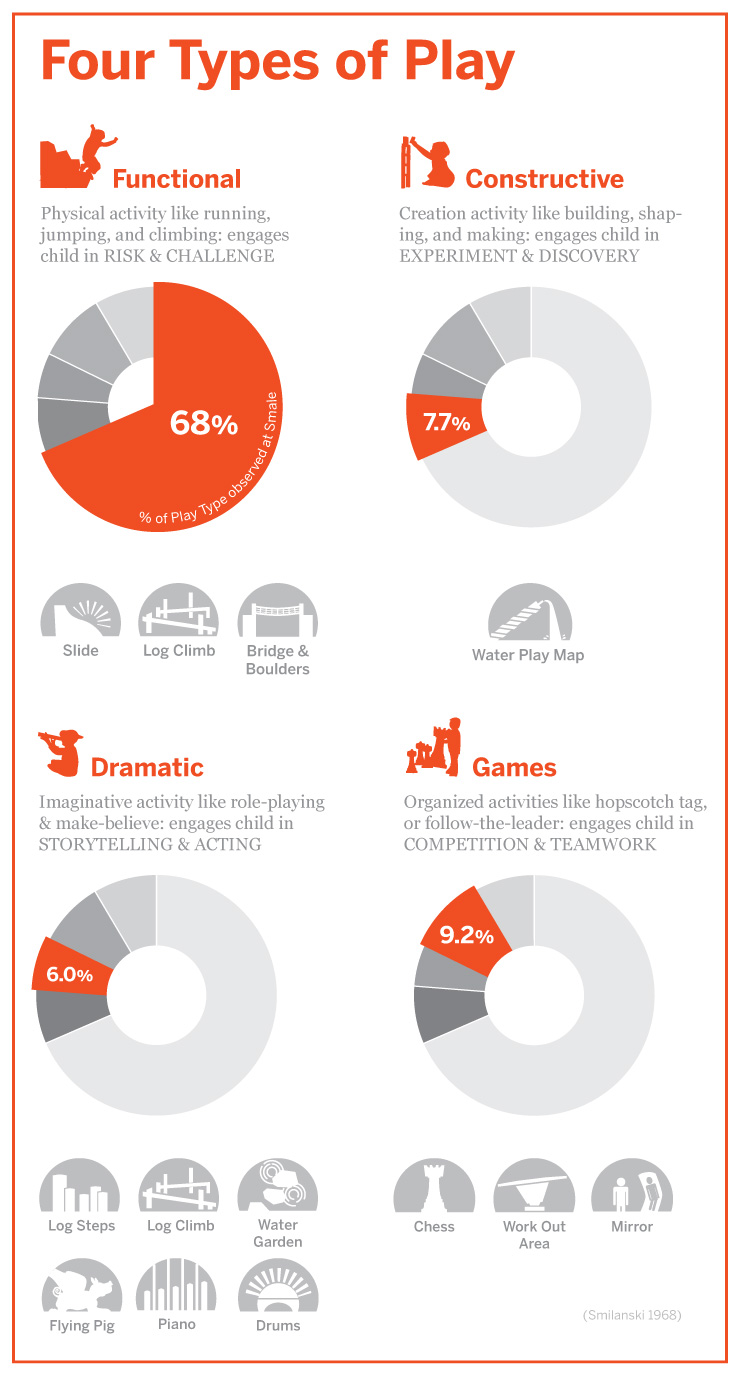
Incorporating constructive play into the playscape proved to be the most difficult. Nationwide, constructive play environments that include loose parts to manipulate – like sand, water, or blocks – tend to be challenged in urban public parks. Municipalities cite concerns over maintenance costs and keeping playgrounds looking “neat” while citizens express fears over safety and what things could be hidden in sand. At Smale, the large sloping lawn that today occupies the area north of the valley was, for most of the design process, conceived of as a sand-and-water play zone, where children could freely manipulate the environment to create whatever struck their fancy: from castles, to sculptures, to rivers and dams, or even bakery delights. In the end, local concerns regarding keeping public sand boxes clean and safe for children won out, and the sand area was eliminated.
At the same time, the design process for the P&G goVibrantscape was just beginning and early concepts immediately hit on providing a place for children to manipulate water, without the sand. The water play map, which allows children to pump, dam and channel water in order to flood a miniature granite-relief version of the park, grew out of an intensive process with Richter Spielgerate, a German manufacturer of alternative playground equipment, to identify the maximum interactive play value and layout of elements. We traded sketches back and forth for months, as the design grew from a simple water basin and runnel into an engineer’s paradise. The miniature map of the city took shape first as a digital model, then as a full scale mockup in our office and was ultimately CNC milled by Coldspring Granite.
Richter also helped to customize their signature Ornithopter play element into what we like to call the “Oink-i-thopter”. Cincinnati, known to some as “Pork-opolis” has long embraced the flying pig as its mascot, a symbol that evokes both the city’s commercial and industrial roots as well as its aspirations and sense of humor. The flying pig creates a sense of place while engaging many children and families to create movement together. Children and adults climb up a ladder into the pig while friends and family pull on ropes to flap the pig’s wings and give those inside a ride.
The Impact
The two playscapes opened within a few weeks of each other in the late spring of 2015. It was immediately clear that they were a hit. We heard from local contacts that the features were “standing room only” and “crawling with kids”, and social media channels were alive with positive feedback. As excitement about the playscapes built over the course of the summer, Sasaki became interested in understanding, and learning from, this project. We wanted to unpack how children and families use the playscapes – how they travel through them, what features captivate attention most and what kinds of play activities they inspire. We were also curious about how the park was performing from a maintenance and safety perspective. And so, supported by an internal Sasaki research grant, our team began a rich exploration of contemporary play at Smale Riverfront Park.
Our research team – three landscape architects and one intrepid four-year old research assistant – traveled to Cincinnati to collect data on a sunny weekend in mid-October. Armed with clipboards, cameras and copious data collection sheets, we logged more than 45 observation hours in the park and conducted more than 100 interviews. Our chief methods included four activities: counting, tracking, listening, and interviewing. Every 30 minutes throughout the weekend we conducted a full count of the people in the playscapes, capturing where children, adults, teens, strollers and dogs were distributed. Tracking consisted of mapping one child’s journey for ten minutes, noting his or her complete path through the playscape and observing key moments. We tracked two to three times every 30 minutes. We conducted interviews with both visitors and stakeholders, including key park maintenance staff and leadership. And key to our qualitative data was intensive listening: we sat in each play zone for 10 minutes at a time and wrote down all comments and conversations. We joke that, in retrospect, listening was the creepiest part of the research effort, but it yielded excellent insights about types of play occurring in each zone.
Beyond these formal methods, which generated mountains of excellent quantitative and qualitative data, the experience of spending an entire weekend immersed in the park was transformative. Subtle changes in sunlight, wind, and temperature over the course of a day gave us ever-changing new perspectives on the park. Swells and ebbs of background noises like voices, footfalls, laughter, traffic, and riverboats produced a constant hum of activity. As countless families arrived, played, and departed we spent time watching and occasionally joining in the play. We shared the joy and pride of first ascents up the climbing wall, the laughter of families riding in the flying pig for the first time and the momentary tragedies of skinned knees and elbows.
We returned to Boston with a substantial amount of data, both qualitative and quantitative. As we comb through it, we keep making new discoveries, but four key trends have emerged. First, the playscapes at Smale have a high level of intergenerational integration. At most standard playgrounds, there is a simple pattern: children play on the plastic structure, while parents mill about on the outskirts. Conversely, at Smale the densities of children and adults were relatively even across all play zones. Adults weren’t just watching children on the flying pig, they were climbing up for a ride themselves or helping to pull on the wings to create the flying motion. At the climbing walls and log climbing feature, adults were both spotting children and trying out the holds themselves. One father told us: “[this park] is fun and challenging, so different than our neighborhood tot lot…I can’t help but join in the playing!” The perception of risk also made many parents stick more closely to their children than usual. At times children were asking for help with a difficult move, and at other times parents were nervously hovering and telling children to be careful.
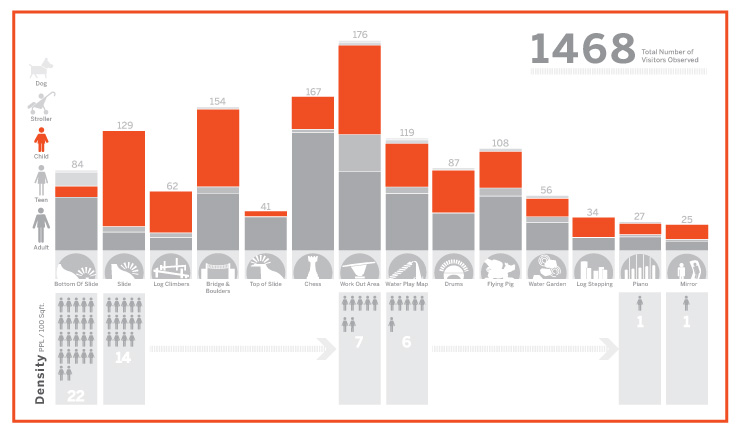
Second, design layout has a strong effect on patterns of movement. The PNC/Heekin adventure playscape, on the east side of the bridge, is designed as one fluid playscape, with different play elements linked together in a similar way to a climbing structure. Children moved in fast, iterative, and looping paths here. Parents traveled loosely with their kids, but also stopped to watch at times from key vantage points, like the bottom and top of the slides or the ends of the valley. The P&G goVibrantscape, on the west side of the bridge, is laid out as separate play “rooms” arranged along the central spine of the historic Water Street. Parents and children traveled in family groups from room to room, rarely returning to a room after leaving it. The marked difference between movement patterns on the east and the west speaks to the rise of the continuous play concepts in the 1980s. Early playgrounds tended to be object focused: a swing, a see-saw, a ladder, and slide element – all placed separately on a flat plane. Continuous play, credited to Steve King of Landscape Structures, captures the idea of linking play moments together into a fluid experience: from the pinnacle of one feature you can always see another adventure. This thinking gave rise to the kind of conglomerate play structure so familiar on today’s standard playgrounds, but is also useful in designing custom playscapes that will keep children running from one exciting experience to the next.
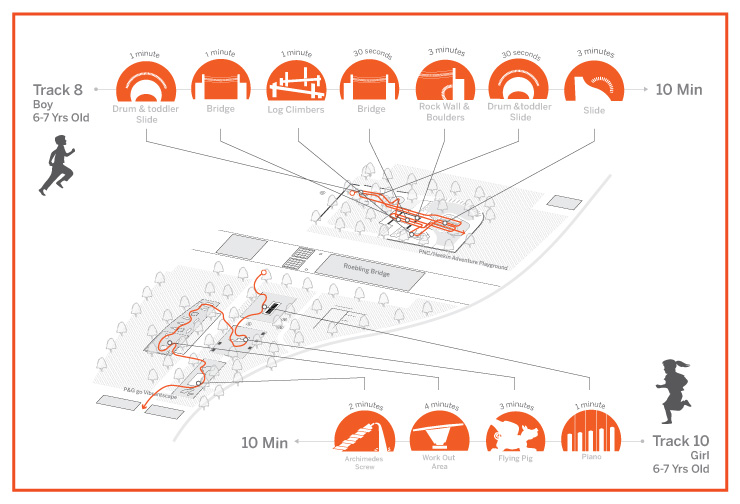
Third, despite design considerations and operational measures in place, some kids will use the playscape in unintended ways. On standard playgrounds, it’s common to see kids climbing backwards up the slides, monkeying around to the outside of high guardrails and swinging from the tops of shade trellises. Some children are hard-wired to make their own challenge, even if that appears dangerous or undesirable to adults. This holds for Smale, where children who want to be creative have plenty of opportunities for upping the ante, despite the fact that the custom playscape meets all safety standards. One group of boys used the Heekin playscape as a parkour training ground, doing back flips off the rocks, frog-leaps over the climbing logs and vigorous swinging on the rope bridge. Children use the sloped concrete next to the slides as much as the slides themselves, and climb to the very top of the pig rather than just inside the cockpit. Instead of just working together to get the balancing disc level, some groups play a game where one person spins the disc in an attempt to get others to lose their balance and fly off. Although these behaviors could be regarded as simply dangerous, they are also markers of creativity and innovation and an important part of children claiming the space as their own.
Finally, constructive play in the playscape is just as valuable as challenging physical activity. The new generation of adventure playgrounds, like Heekin, excel at inspiring physical activity, a sense of risk and the feelings of pride that go along with accomplishing a difficult challenge. Our play typology mapping of the Smale playscapes revealed active physical play occurring across the entire playscape. But constructive play, where children are experimenting and making discoveries is essentially isolated to the water play map. Although our data from a cool October weekend indicated only an average play density at the water map, we heard again and again from stakeholders and families how hugely popular the area is during the summer. One caregiver who runs a nearby daycare told us, it was “the perfect place to get wet [and kept the kids] interested for so long. [It was] always so crowded…I wish it were bigger.” Over the course of a weekend we witnessed countless moments of experimentation, creativity and discovery as children pumped, dammed, diverted, released and splashed water. The air was full of questions like “what happens if…?” and declarations like “look what I did!”. One girl’s father watched her open and close spigots in a certain order and asked her what she was doing. “I’m engineering,” she told him matter-of-factly. Constructive play is critical for nurturing the kind of creative thinking currently in decline,3 and there is clearly an unmet appetite for more of it in the park.
These four big take-aways gloss over a million nuances of the post-occupancy data, but together they highlight how the park has developed a life of its own. As designers, funders, clients and stakeholders – we all dream big about what a park can be, but in the end it is the children, families, and community that really define what it is. How they use the playscape, what they love and what they neglect – these are critical drivers of the park’s future, and also key learning moments for future designs. Sasaki is currently developing partnership models with a local university to continue gathering post-occupancy data throughout the coming summer. At the same time we are already applying thinking around layout, unintended uses and constructive play to new playscape projects.

As the sun starts to shift behind Paul Brown stadium casting long shadows in the park, I wrap up a final interview and tuck away my clipboard. Despite the imminent dusk and the cool air, there are still families enjoying the park. Tess is over at the water play map: she has made friends with another little girl, perhaps five years old, and they have been moving water together for almost 30 minutes, a near-eternity for the preschool bracket. I hear Tessa’s friend shout “are you ready?” and Tessa nods vigorously, her eyes fixed on the stainless steel channel in front of her. As the friend begins pumping water, I walk closer and see that they have placed two twigs in the channel. “Is it working?” the friend asks, and then, unable to contain herself, stops pumping and runs over to see. The three of us watch the water flood the channel, lifting the twigs and carrying them to the end where the girls have left one rubber stopper open. The first twig spins and dives neatly through the hole to fall on the granite map below. The second gets caught sideways and remains as the last of the water drains out. “One boat did the waterfall, and one just did the rapids” explains Tess, and they both laugh.
The friend bounds off to retrieve the sticks, but Tessa stays close. “Mama”, she says, leaning her head into my hip, “I’m tired.” And it’s no surprise: she has been playing hard since nine-thirty in the morning.
Maria Montessori, founder of the popular pedagogy that bears her name, said famously “play is the work of the child,” and today I believe it wholeheartedly. Tessa, and her peers, numbering more than eight-hundred that day, have explored every inch of the park. They have done many of the things we designers might have expected, and have also innovated and discovered new ways of playing in the space that we never could have imagined.
As we begin to climb the steps up to downtown Cincinnati, Tessa turns around and tugs my hand: “But can we come back tomorrow?” As it turns out, we can: this is the perfect collision between work and play for both of us.
Sources
(1) The Trust for Public Land, Center for City Park Excellence, 2014 City Park Facts: bit.ly/2bfn2R7
(2) Journal of Pediatrics, Societal values and policies may curtail preschool children’s physical activity in child care centers. Copeland, et al. 10.1542/peds. 2011-2102
(3) Creativity Research Journal, The Creativity Crisis: The Decrease in Creative Thinking Scores on the Torrance Tests of Creative Thinking. Kyung Hee Kim, 23:4, 285-295. 2011
(4) Evolutionary Psychology, Children’s Risky Play from an Evolutionary Perspective: The Anti-Phobic Effects of Thrilling Experiences. Sandseter, et al. 9(2): 257-284. 2011
(5) The Atlantic Magazine, The Overprotected Kid. Rosin. April 2014: theatln.tc/2bfq2x2
(6) International Journal of Environmental Research and Public Health, What is the relationship between risky outdoor play and health in children? A systematic review. Brussoni et al. 12(6), 6423-6454. 2015
From Design Museum Magazine Issue 001
